|
Planting
Take advantage and do some early spring planting, but only on clement days. You can never have too many climbers and twiners, and now is the ideal time to get them in. They take up little ground space, so they’re perfect for smaller plots, and then they grow up towards the sunshine giving you flowers at eye-height. Some will need support, others will cling on to a wall, and some will flop alluringly, but they will all offer a vertical accent to link garden and sky.
Self clingers
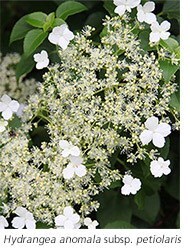 Self-clinging climbers attach themselves to masonry with adventitious roots, they can climb into guttering and into the eaves, but planted in the right place they soften brickwork and provide a natural barrier between garden and house. Many are also useful in shade. The dainty white lacecap flowerheads of the climbing hydrangea, Hydrangea anomala subsp. petiolaris look divine in soft light, with their tiny fertile flowers surrounded by larger petalled sterile flowers. The neatly serrated green leaves add even more cool charm. There’s also a variegated form, Hydrangea anomala subsp. petiolaris 'Silver Lining' (PBR) with grey-green leaves irregularly margined in sauce-hollandaise shades. This will need a lighter position, because the partly-green foliage will produce less chlorophyll than the all-green forms. On the plus side variegated foliage usually indicates drought tolerance, because the paler parts of the leaf transpire less. On both of these hydrangeas, the brown bark curls away from the stems when the leaves fall in winter, and this adds seasonal interest. The similar Schizophragma hydrangeoides is slower and needs a little more cosseting and, like all Japanese plants, it’s used to a rainy season in early summer. Water it well until it’s really established, during June. The flowers of schizophragma have one large bract, rather than four separate petals of the hydrangea, and newly planted specimens will need to be securely tied to a framework to encourage aerial roots. A good tip for both. Self-clinging climbers attach themselves to masonry with adventitious roots, they can climb into guttering and into the eaves, but planted in the right place they soften brickwork and provide a natural barrier between garden and house. Many are also useful in shade. The dainty white lacecap flowerheads of the climbing hydrangea, Hydrangea anomala subsp. petiolaris look divine in soft light, with their tiny fertile flowers surrounded by larger petalled sterile flowers. The neatly serrated green leaves add even more cool charm. There’s also a variegated form, Hydrangea anomala subsp. petiolaris 'Silver Lining' (PBR) with grey-green leaves irregularly margined in sauce-hollandaise shades. This will need a lighter position, because the partly-green foliage will produce less chlorophyll than the all-green forms. On the plus side variegated foliage usually indicates drought tolerance, because the paler parts of the leaf transpire less. On both of these hydrangeas, the brown bark curls away from the stems when the leaves fall in winter, and this adds seasonal interest. The similar Schizophragma hydrangeoides is slower and needs a little more cosseting and, like all Japanese plants, it’s used to a rainy season in early summer. Water it well until it’s really established, during June. The flowers of schizophragma have one large bract, rather than four separate petals of the hydrangea, and newly planted specimens will need to be securely tied to a framework to encourage aerial roots. A good tip for both.
 If you want a not-too vigorous creeper to scale an ugly wall, perhaps the extremely handsome Parthenocissus henryana, which has black tinged five-lobed leaves attractively etched with white veins and midribs, is worthy of consideration. Augustine Henry (1857–1930), a customs officer stationed in China, lent his name to this and many other plants with stunning foliage. The leaves will colour up to crimson in September, but only in bright positions, and this Chinese Virginia Creeper (as its confusingly called) thrives best on a warm wall. If you want a not-too vigorous creeper to scale an ugly wall, perhaps the extremely handsome Parthenocissus henryana, which has black tinged five-lobed leaves attractively etched with white veins and midribs, is worthy of consideration. Augustine Henry (1857–1930), a customs officer stationed in China, lent his name to this and many other plants with stunning foliage. The leaves will colour up to crimson in September, but only in bright positions, and this Chinese Virginia Creeper (as its confusingly called) thrives best on a warm wall.
Even more autumn fire can be had from the large-leaved vine, Vitis coignetiae, and this loosely draped climber arranges itself in gentle swags via its tendrils, so it’s often used round stone pillars and along porticos to give a classical edge to a garden. It’s vigorous, with large leaves and small black grapes that are no good to eat, but it’s grown for its enduring autumn colour which again is more pronounced in warmer sites. As with all grapes, only ever cut them back in mid-winter, or they will bleed and become weak.
Twiners
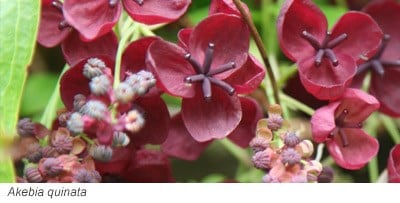
Twiners twist their stems, like a serpent, in order to scale the heights and they need a framework - be it a tree, a shrub, or a pergola. Bonding together with a friend for support creates a partnership, a tight duo, and the skill is finding two plants that flatter each other and co-exist together. The Chocolate vine, Akebia quinata, is a clockwise mover, and once established it produces wine-red petal-like bracts set round a jester cap of 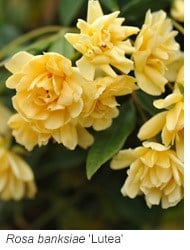 black stamens. These are displayed against bright green leaves and, if it’s in a warm spot, some of the leaves cling on in winter keeping the show going. It’s also possible to catch the vanilla scent in summer. It can be sombre on its own, but lights up planted with a deep-blue clematis, such as ‘Etoile Violette’. Akebias take their time to climb, so be patient because they’re worth it. I’ve also seen it looking handsome, scrambling with the yellow May-flowering rose, Rosa banksiae ‘Lutea’, along a warm wall. black stamens. These are displayed against bright green leaves and, if it’s in a warm spot, some of the leaves cling on in winter keeping the show going. It’s also possible to catch the vanilla scent in summer. It can be sombre on its own, but lights up planted with a deep-blue clematis, such as ‘Etoile Violette’. Akebias take their time to climb, so be patient because they’re worth it. I’ve also seen it looking handsome, scrambling with the yellow May-flowering rose, Rosa banksiae ‘Lutea’, along a warm wall.
The ultimate twiner is wisteria and these have to be grafted in order to flower well when young, so they tend to be pricey. However never did the phrase you get what you pay for be truer than it is with wisteria. Wisteria floribunda 'Yae-Kokuryu' (previously known as ‘Black Dragon’) has densely packed violet-blue flowers. It's a Japanese wisteria, so form the J with your finger to remind you that these twine anticlockwise. These are hardy and flower in May and June, looking their best on a pergola grown as a solo item.

The much more vigorous Wisteria sinensis, known as Chinese wisteria, flowers before the foliage opens and often there’s a flush of bronzed new foliage to frame the flowers. These can be more frost-prone, however the flowers pack a seriously sweet fragrance and a few flowers often appear in August, after the main May flush. Make a C with your finger, as an aide-memoire that Chinese wisterias twine clockwise. W. sinensis 'Amethyst' is an award-winning variety with dark-violet flowers that soften to parma-violet.
When planting allow the main stem to reach your desired height and then cut out the top so it produces side shoots. After that pruning is a two stage affair designed to produce flower buds rather than leaf. Stage one takes place in July and any long leafy shoots that are cut back to four to six leaves towards the ripened wood. Once the plant is dormant, prune again in February or early March, leaving just two buds on each shoot to create a skeletal framework. This will let in more light and ripen the wood, encouraging more flowering spurs and fatter flower buds. After a good summer your wisteria should drip with bloom every spring. This twice yearly prune will also keep the plant compact, making it less prone to wind damage should gales occur.
Wisterias have pea-shaped flowers and in common with other plants with pea-shaped flowers they should not be given any nitrogen-rich food. They fix their own nitrogen at the root and, if given extra nitrogen, they will produce leaf at the expense of flower.
 The wisteria is an exotic oriental, but our native woodbine, Lonicera periclymenum, is a British woodland-edge native that flowers in summer. It’s sweetly fragrant, unlike the brasher American species which are hummingbird pollinated, and the flowers come in rhubarb and custard colours that marry well with golden, pink or peachy roses. There are three of note. ‘Belgica’ is a traditional rhubarb-pink and custard yellow that flowers in midsummer. ‘Serotina’ is later to flower, with crimson-purple and pale-cream flowers arranged in a neater head. ‘Graham Thomas’ is greyer-leafed with plain custard-yellow flowers that endure through into autumn. Plant in good soil and allow them to twine up towards the sun. They do take four years or so to form a good plant, but they can be added to the shady side of a hedge, or woven through roses, or trained round a pillar, or they can adorn a west-facing wall. They come into their own in the evening, when those long trumpeted flowers attract the larger moths. The wisteria is an exotic oriental, but our native woodbine, Lonicera periclymenum, is a British woodland-edge native that flowers in summer. It’s sweetly fragrant, unlike the brasher American species which are hummingbird pollinated, and the flowers come in rhubarb and custard colours that marry well with golden, pink or peachy roses. There are three of note. ‘Belgica’ is a traditional rhubarb-pink and custard yellow that flowers in midsummer. ‘Serotina’ is later to flower, with crimson-purple and pale-cream flowers arranged in a neater head. ‘Graham Thomas’ is greyer-leafed with plain custard-yellow flowers that endure through into autumn. Plant in good soil and allow them to twine up towards the sun. They do take four years or so to form a good plant, but they can be added to the shady side of a hedge, or woven through roses, or trained round a pillar, or they can adorn a west-facing wall. They come into their own in the evening, when those long trumpeted flowers attract the larger moths.
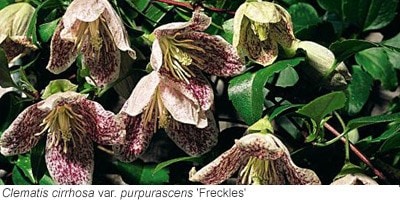
The clematis, the queen of climbers, is a garden essential and there’s at least one for every time of the year. Winter-flowering clematis need a warm, south-facing wall and the earliest are forms of Clematis cirrhosa, a clematis with green-tinged pendent bells that you gaze up into. Clematis cirrhosa var. purpurascens 'Freckles' always flowers earliest, often spanning the year, and the white flowers are heavily spotted in red. C. cirrhosa var. balearica is much subtler, with lightly spotted greenish-cream four-petalled flowers set off by dark, ferny foliage. Or there’s C. cirrhosa var. purpurascens 'Lansdowne Gem', a new ruby-red flowered form. These clematis are never pruned, although they can be given a very light tidy after flowering once established.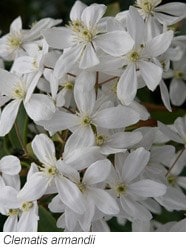 In dry summers these winter scramblers can shed all their leaves in August, but they revive once autumn rains return. In March the leathery leaved evergreen C. armandii performs, but this needs far more space - again on a warm wall. In dry summers these winter scramblers can shed all their leaves in August, but they revive once autumn rains return. In March the leathery leaved evergreen C. armandii performs, but this needs far more space - again on a warm wall.
Spring-flowering clematis tend to have an alpine provenance, which means that they are very hardy in well-drained positions. They also tolerate windy corners and can be very useful, because their flowers, which are held aloft on long trembling stems, appear as the foliage breaks. This makes them look very spring-fresh. ‘Frankie’ has open mid-blue flowers and a hint of green to the stamens. ‘Markham’s Pink’, an old variety, has a cool pink ragged tutu, but it’s a good survivor so well worth growing. Clematis macropetala 'Lagoon' is a soft blue, ragged skirted clematis, and ‘Wesselton’, a paler blue with pointed petals. These hardy clematis are never pruned, only tidied, and they take their time to make a show.
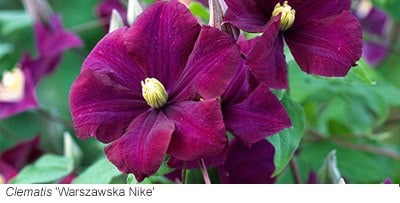
The easiest group to grow are the midsummer-flowering Viticella group, because these are vigorous enough to be cut down to the lowest buds every spring. For this reason the alpinas and viticellas need to be separated, otherwise you will be faced with a mixed tangle of stems. ‘Flore Pleno’ is a deep purple double, ‘Niobe’ is a red velvet and 'Warszawska Nike' a pinwheel of red-striped purple. Viticellas lightly scramble and can be grown through shrubs, over rambling roses, or up trees.
Finally, don’t ignore foliage. Some of the larger-leaved variegated ivies thrive in dank corners and Hedera colchica 'Dentata Variegata', which will need the support of wires, will cast its own light and shade on a wall. Or you could allow it to tumble over a low wall.
|
Five things to do
|


























